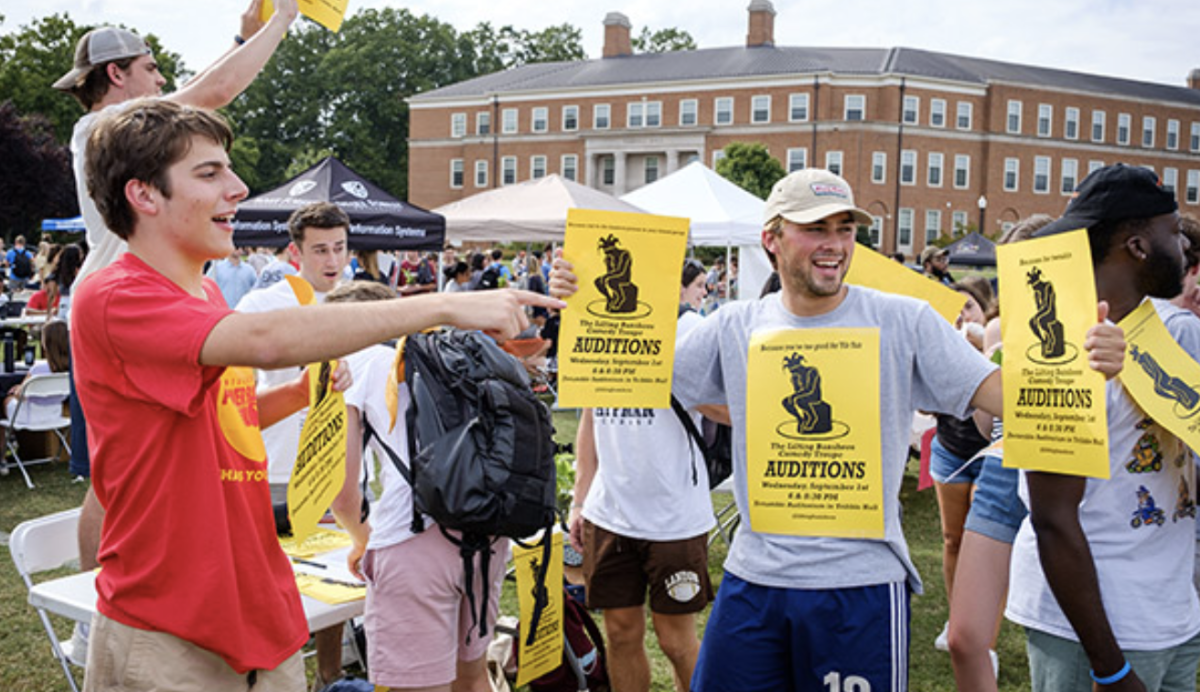It is a hot and sweaty September afternoon on the Wake Forest campus. Excitement about the new school year radiates from all students with their ambitions set high to go above and beyond. The club fair is filled shoulder-to-shoulder with students filing through the rows of tents. People navigate through, grabbing fliers and scanning the barcodes that their peers cheerfully offer them.
Students, especially freshmen, leave with their arms full of fliers and handfuls of bribery candy from nearly every tent. It is evident from this event alone that there is overwhelming excitement about joining clubs at Wake Forest.
Clubs, at their root, are meant to help students find a place in college, and luckily, there are a range of clubs that cater to a wide range of students.
For a student like Grace Lyu, an international freshman from Shanghai, China, finding a place can be especially stressful.
“As a freshman, and especially as an international student, I had [fear of missing out] very often when school first started,” Lyu said. “I was worried the first two weeks about making friends, but the club fair really helped me to find a place here at Wake [Forest].”
Clubs, in general, allow students to reside among peers who share their niche interests.
“I no longer felt pushed to socialize with people in areas I’m not interested in,” Lyu said. “I joined the ultimate frisbee club because I’ve been playing that sport for three years now. Meeting new people with common interests and having fun together is way easier.”
Another easy way to get involved is through service organizations.
It is evident that Wake Forest students value the importance of service and live up to the pro humanitate motto. With various flyers handed out across campus and information tables set up well before clubs fair, Hit the Bricks is one of Wake Forest’s most popular service opportunities.
The event raises money for the Comprehensive Cancer Center through running or walking laps around Hearn Plaza. At this year’s event, participants logged 21,605 laps and raised over $300,000 — a record-breaking number. Hit the Bricks Executive Director Abby Draeger revealed that there is an opportunity for varying levels of commitment within the organization.
“From our low-commitment ambassador program to our dedicated senior leadership, we foster involvement at every level,” Draeger said.
For Hit the Bricks, creating easy-access involvement is crucial for raising money. The more participants, the better. Additionally, the club intends to leave a legacy.
“Through this experience, we’re not just organizing an event. We’re building a tight-knit community that spans [across all classes],” Draeger said.
Hit the Bricks stood out to many, which can arguably be attributed to the immense recruiting efforts done by the club’s leadership. As Draeger expressed, holding a leadership position in a club committed to service has been rewarding.
“Leading Hit the Bricks has not only enriched my experience but also provided a profound sense of purpose knowing that we’re making a tangible difference in the fight against cancer and fostering a strong sense of community within Wake Forest,” Draeger said.
Hit the Bricks makes evident that binding students through service is at the forefront of Wake Forest’s community engagement.
Another popular yet more artistic club is Innuendo. Innuendo holds auditions for students to join and partake in what was Wake Forest’s first co-ed a cappella group. The group performs a variety of pop and alternative music and is a fun way for students to get involved.
“Innuendo a cappella has become a true outlet for my musicianship, friendship and leadership,” Club President Hannah Murrow said.
Innuendo has become a safe space for students to express their creativity on campus and allows students to gather in community-building.
“A cappella has given me a space to be bold and step out of my comfort zone in an environment with absolutely zero judgment and with people who love to celebrate each other’s talent,” Innuendo member Elicia Estevez said.
While clubs range from projects to service outlets to fraternities, the members of these clubs are passionate about their community and emphasize the importance of their respective organizations. But are some clubs seen as more valuable than others? Does competition directly relate to how highly regarded a club is on Wake Forest’s campus?
Certain organizations on campus are much more difficult to join than others.
An article by The Atlantic describes the club culture at elite colleges such as Yale as being extremely selective. For some clubs at Wake Forest, this culture is evident.
An ambitious freshman Charlie Comeau seeks out the business fraternity, Alpha Kappa Psi (AKPsi). AKPsi is a unique hybrid of a club and fraternity that requires its members to undergo a highly competitive rush process. The business fraternity is notoriously competitive among prospective business major students, as it provides skills and strategies that are seemingly integral to an undergraduate’s path to Wall Street.
Comeau mentioned his interest in this aspect of AKPsi.
“I wanted to join because it’s great for professional development,” Comeau said. “They network with alumni brothers, so it’s great for getting to know people who have graduated.”
However, this “golden-ticket club” comes at a cost. One must navigate applications and interview processes during the fraternity’s rush week. AKPsi showcases grueling competition and hungry ambition during rush week, and prospective members are required to wear suits and engage in interviews with recruiting AKPSi students.
Comeau describes the experience as “[wicked] competitive,” with approximately 250 people at the rush event.
“Everyone would try and spend as much time around the rush chairs, president and vice president, so when we did get to talk to them it was like fighting to get a word in, trying to be memorable in some way,” he said.
AKPsi remains extremely selective, only admitting a small percentage of its many applicants. However, while clubs on campus range in size and popularity, most are easy to join as opposed to the harsh club culture at other elite institutions.
It can be speculated as to whether the selectivity of certain clubs is reflective of which extracurriculars and interests are valued at a higher level at Wake Forest, or if the competition is simply to narrow down the most serious members. Nonetheless, there is a club for anyone willing to get involved.








